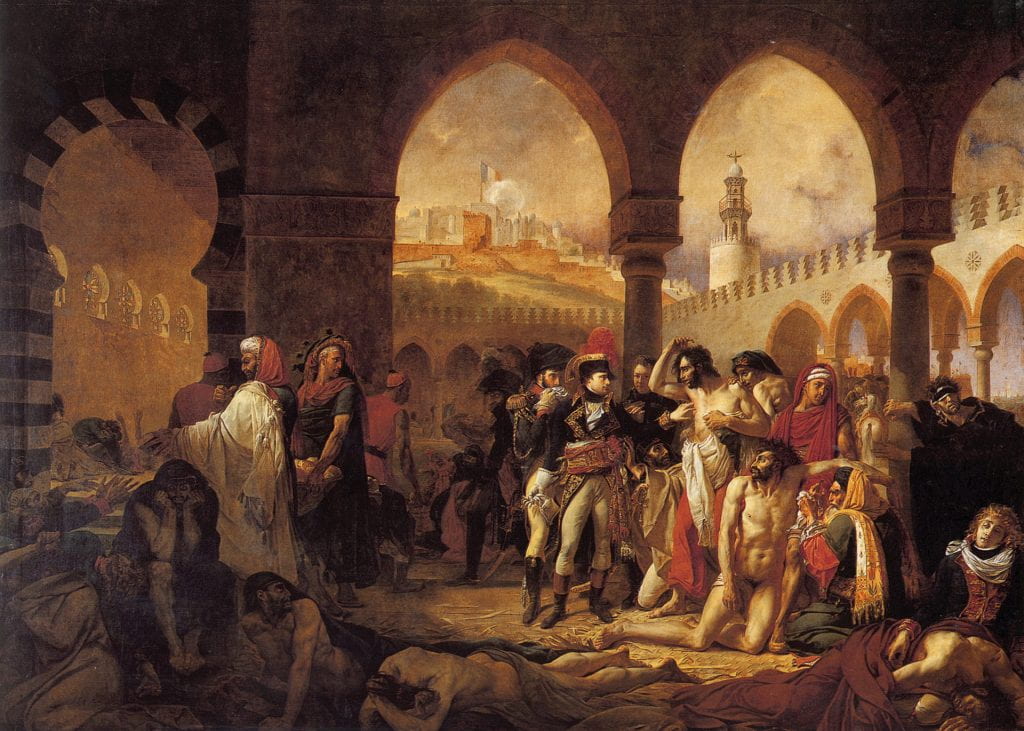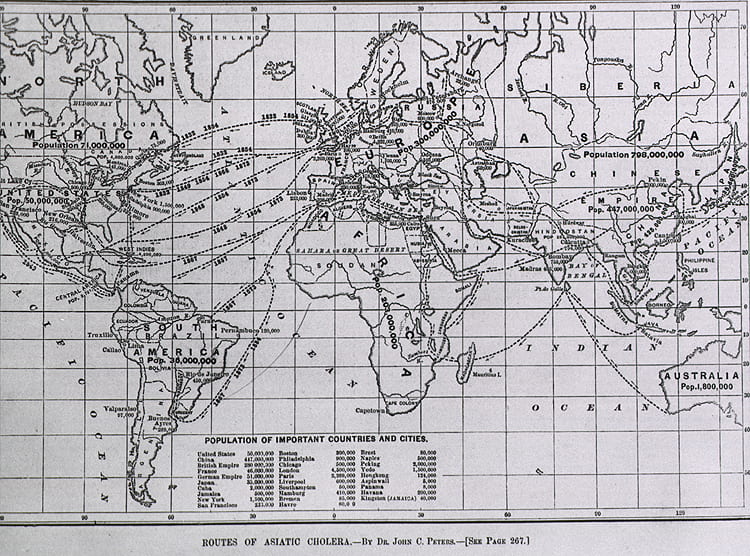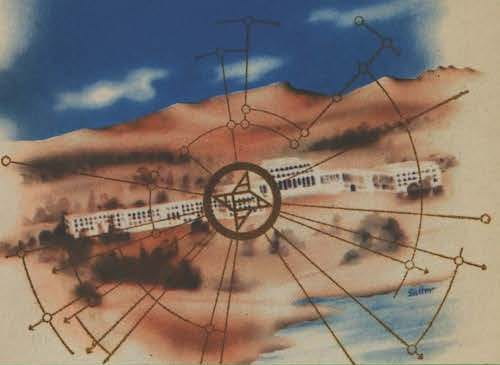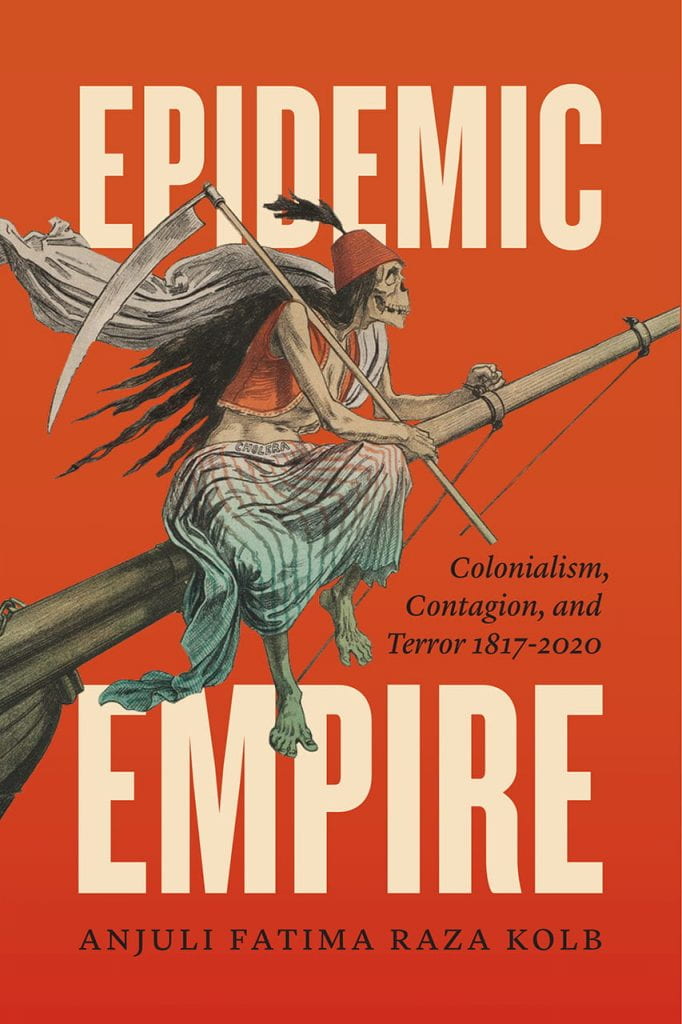Anjuli Fatima Raza Kolb is associate professor of English at the University of Toronto. She is a scholar of colonial and postcolonial literature and theory with particular research interests in the history of science and intellectual history, poetry and poetics, gender and sexuality studies, political theory and independence movements, the gothic and horror, and comparative literary studies. Editor Anne Schult spoke with her about her first scholarly monograph, Epidemic Empire: Colonialism, Contagion, and Terror, 1817-2020 (out now with University of Chicago Press), which lays out the literary and discursive history behind the ubiquitous figure of the “terrorism epidemic,” locating the origin of contemporary global Islamophobia in the post-Mutiny British empire, and assessing the contemporary “epidemiological” approach to terrorism as a legacy of therapeutic empire.
***
Anne Schult: Over the course of the Covid-19 pandemic, reflections on contagious disease as allegory have abounded, and some of the most canonical texts engaging with this trope—from Susan Sontag’s Illness as Metaphor to Albert Camus’ The Plague—have regained popularity in public discourse as commentators are trying to make sense of the current public health crisis. In Epidemic Empire, you also draw on these (and many other) writings but place them at the very specific discursive nexus of epidemic, terror, and Islam. In doing so, you not only trace how disease has been used rhetorically to pathologize and dehumanize political resistance since the nineteenth century, but also expose the historical concurrency of insurgency and contagious disease in British India and their consequent stylization as inextricably related epistemological problems across the British, French, and American empires. What aspects that have hitherto remained hidden or obscured about the “epidemic imaginary” does this explicit focus on colonial, anticolonial, and postcolonial politics reveal, and how might these explain its continuous appeal?
Anjuli Fatima Raza Kolb: You’ve identified really carefully the process I unfold in the book: the way metaphors of disease— and in the story-length register, allegories of epidemic, like Camus’s—naturalize political violence along the lines of an earthquake, or an extinction event, as if they are part of earth’s in-built life cycle. In earlier imperial writings about nature and the natural world, you also see natural phenomena being described as revolutions, upheavals, or the violence of nature. Think Alexander von Humboldt, trained as a geologist for the purposes of mining, observing the earthquakes in the new world, or the term “rogue wave,” denoting a break in tide patterns but also connoting a vagrant or a beggar by way of the Latin rogare.For catastrophes and novel events—events we might call sublime, or at least out of the realm of the everyday—speakers of many languages use the tools of comparison to assist in sense-making. Why are fish dying in freshwater streams? Well, it is like a sickness spreading through the land. What is cancer? It is like a mutiny inside the body that grows and spreads. These are simple similes, but they help show us the process you need to interpret them because you can see very clearly that the terms on each side of the equivalence must be unpacked if you want to really understand what they mean, who they serve, which ways of thinking are assumed to be shared or common-sense, and finally what logics are promoted through them.
Another way of saying this is the metaphor always begs the question: to whom is this event surprising, new, in need of a comparison in order to understand it? This is a silly example, but a pervasive one: if you live in North America and have a name or eat foods that seem to some “foreign,” one of the first things a European descendant will often do on encounter is try to liken your name or food to something familiar: “Oh, like Angelina!” or “…so your Christmas dinner is like…Indian tacos?” You can see right away that such operations assume a stable state of the human, and then variants on, additions to, or even challenges to that presumed whiteness. For many centuries, the task of shoring up “human” knowledge has been understood by the West—in concert with the projects of educational and humanitarian missionarism—as its rightful and sole inheritance. So let’s say metaphors are everywhere in human thought, but the ones I am most interested in are the ones attached to power. Those are the ones that determine who lives and who dies, how justice is twisted and thwarted, and what governs the making of a global system.
To get to the specifics of your question, theorists of what I call the “epidemic imaginary” have taught me that disease is far from a “natural” occurrence, in the sense that it is deeply social, and completely enmeshed in human behavior. The writings of Hans Zinsser, Georges Canguilhem, David Arnold, Priscilla Wald, Alan Bewell, and many others are central to my thinking. I don’t think these writers missed anything! Each of these theorists, to varying degrees, also examines or acknowledges the construction of disease as a raced concept from the Athenian plague forward. Which is to say, I don’t feel this book uncovers something hitherto hidden. Instead, I think of it as bringing these lessons to a particular problem that is the defining problem of North Americans of my generation: the revival of hard-line imperialism by the US after 9/11.
I think a lot of people who are genuinely against occupation and imperialism would intuit easily the arguments I make in this book: the War on Terror is a neo-colonial war dressed in pathogenic logic and therapeutic excuses. What I wanted to show, and what I hope I do carefully, is to provide a record of exactly how the epidemic imaginary consolidates and creates our geopolitical present, which is one marked by both Islamophobia and now a global pandemic exacerbated by and exacerbating health inequity. The last thing I’ll say on this is that epidemic is an age-old concept, but the study of epidemics through the discipline of epidemiology is not. It’s a historical occurrence that lines up with the East India Company’s expansion, and later the establishment of the Imperial government in India in the middle of the nineteenth century (or, as I sometimes think about it, the cholera century) and the French expansion into North Africa and Egypt. Tropical medicine, for example, has a slightly different geography and history, centered more in the Caribbean and sub-Saharan Africa. There is an extremely rich scholarship in this field as well that links these earlier scientific moments to neglect and the criminal and deliberate impoverishment of Caribbean, African, and Indigenous communities.

AS: You are a literary scholar by training and base part of your argument on the narrative link between rebellion and disease in canonical Anglophone and Francophone literature, including Rudyard Kipling’s Kim, Bram Stoker’s Dracula, Albert Camus’ The Plague, and Salman Rushdie’s Satanic Verses. Yet in many ways, Epidemic Empire departs from the purely literary realm and offers a much broader history of the present. Time and again, your research reveals, the “terrorism epidemic” that appears as a narrative trope in popular fiction has also been used by government officials to recast military action to crush rebellion as a “natural” defense reaction against an oncoming “plague.” To showcase the continuity of this “descriptive habit” in literary and bureaucratic prose alike, you juxtapose a number of discrete historical events: the British response to the 1857 Indian Mutiny with the assassination of Osama bin Laden in Pakistan through a vaccination campaign ruse (Part I); the Algerian War of Independence as shown in in the film The Battle of Algiers with Pentagon preparations for the 2003 invasion of Iraq (Part II); and Salman Rushdie’s fictional treatment of the Partition of India and its aftermath with reports about mass protests in 2016 Kashmir (Part III). Can you tell us a bit more about your research process and the way you went about linking historical episodes that occurred at times centuries apart?
AFRK: I am lucky to have been exposed to and trained by some of the founding thinkers of postcolonial theory, including those involved in the Subaltern Studies project. From the jump, this was a markedly cross-disciplinary agenda, and also, from the start, these thinkers interrogated colonial archives, forms of knowledge, and asked constantly about what the Western academy—which is the model for many colonial institutions of learning as well—left out or siloed in disciplines that should have been talking to each other. Five theorists who were hugely influential to my early thinking—Edward Said, Gayatri Spivak, David Arnold, Ranajit Guha, and Gauri Viswanathan—worked between archives and times, between literature and other kinds of writing, and insisted on demonstrating continuities between historical moments that at first appear to be discrete. In some cases, the colonial archive and colonial historiography work really hard to make them appear discrete. Each of these thinkers also insisted that these moments in the past had a great deal to teach us about power and inequity in the present. Their archives illuminated so much about what we’ve inherited as common sense. This either was or became completely intuitive to me as a way of working, and then I needed to do the reading and build the skills to make these kinds of arguments myself. That took a very long time.
I also came to literary study sort of sideways, first through what I thought would be a career in medicine, and later through a kind of eclectic undergraduate training in comparative literature that was largely assembled from courses in area studies, theory, and interdisciplinary arts. I was not an English major because I wanted to do courses in music, musicology, art history, Urdu, Middle Eastern theater, South Asian history, and so forth. Landing in an English department for my PhD was a deliberate choice (over comparative literature), but it also meant being “disciplined” to an extent in the ways of working I had avoided. A lot of finishing my dissertation and moving into a tenure track position in an English department became about justifying these sorts of wild moves while also trying to train myself and seek out training in multiple disciplines at once. The research process started as an abstract geometry: here were these five or six historical snapshots in time, recorded in literary and non-literary writing and images. I knew they would tell a story if I could put them together right. I kept reading and reading about philosophies of history, and also reading and reading in those snapshots of time, until I found the right materials to build strong textual bridges between the periods.

Some readers still find these links too artificial, guessing that there’s evidence you could marshal or interpret differently, or offering other examples of the epidemic imaginary that don’t quite fit. I absolutely love those don’t-fit moments, and I look forward to hearing more from readers on this, to being challenged on my version of the history. I am really conscious of parallel stories that have been deeply studied and written about regarding disease, race, war, and the colonization of the Americas through murder and enslavement. Understanding the link between that work and my own will also take time, greater language competence, and further research to flesh out. But I do feel satisfied in the archival and textual backbone of what I’ve done here. Mostly, I hope it’s valuable to others in reframing both the War on Terror and the present pandemic and in inspiring further research.
AS: In order to methodically approach “the meeting point of content and form in the figure of epidemic,” you draw on both “pathotropic” political theory, such as the works of Jacques Derrida and Roberto Esposito, and various histories of colonial science and health politics. How do you situate your work within, or between, these two “canons,” which each come with quite different modes of investigating and conceptualizing disease?
AFRK: This is a beautiful question! To which I must give a sadly unbeautiful answer: I’ve been working hard to avoid situating the work within or between dominant rubrics or methodological schools. It’s not because I don’t admire the work—I have learned so much from both what I’d call biopolitical critical theory (the “pathotropic” observation is my own name for a kind of burgeoning of this work after 9/11, but the theorists themselves don’t use this term) and from historians of colonial medicine and analysts of public health. It’s more that each object—novel, report, testimony, poem, film—I approach demands a different set of tools for interpretation. My teachers, particularly Gauri Viswanathan, whom I’ve been studying with since I was an undergraduate, and who directed my dissertation and continues to influence my work, have very patiently helped me see how to put the object of analysis at the fore, and how to build flexible means of perceiving, reading, and interpreting it. So the method follows the object. I think what links my readings is a close attention to figures and an insistent pressure on patterns. In this way, I really see the book as following Foucauldian and Saidian discourse analysis in terms of how it’s constructed, and Fanonian analysis in terms of how I read my objects. I won’t go too deeply into this because it would unleash an absolute torrent of thoughts about my debts to these three thinkers, but I will say that in spite of his many errors and appropriations of Black thought—particularly Angela Davis’s work on prisons—Foucault’s work made my work thinkable. Edward Said’s method in Orientalism is not discussed enough in terms of intellectual history. He barely reads literature in that book although he reads in a profoundly literary way. And Fanon…what is there to say that is adequate. You can’t think his political philosophy without his ontology, and you can’t read his para-ontology without his psychiatric case studies. That said, I wouldn’t arrogate to slot myself between these people. I guess I would say I try to borrow responsibly from them all, to answer the call of each work—what it knows it’s asking for from the reader, and what it doesn’t know it’s asking for. Maybe it’s also worth saying that relevance to the contemporary politics—especially the politics of race and the ongoing exploitation of the formerly and currently colonized world and peoples—is always front and center for me. If I can’t make what I’m working on speak to something important in our current discursive and political climate, I try again or I put it aside.
AS: In certain regards, your work is also in conversation with more distant scholarship on figuration and metaphors in European intellectual history. Philosopher Hans Blumenberg, for example, whose work has seen a rise in popularity over the past few years, also considered metaphors as epistemological tools. How does your study connect with—or, by contrast, produce tension within—this long-standing intellectual debate on metaphors?

AFRK: Thank you for pointing me to Hans Blumenberg’s work—I wasn’t familiar with it and am now very excited to delve in! Instead of trying to answer the question proleptically (ask me again in a month!), I’ll speak to how I approached what at first appears to be a pretty vast chasm between more formalist approaches to literary figure and the kind of postcolonial criticism that was the crucible in which I read and lived for many years, and which I prioritized in my study of these materials. I noticed the pattern of pathological figuration in the archive of colonial letters before I really thought much about theories of figuration. Kim, Dracula, a bunch of 1890s novels—and then I returned to Guha’s important essay “The Prose of Counter-Insurgency,” which does amazing work in identifying how uprisings are naturalized in the Indian colonial record. So it was a matter of finding in my own memory the text that enabled me to see and read that way, and then studying it carefully again to try to understand its operations and lessons. That essay is very hard! And it was written by a historian who is nevertheless totally attuned to how history is written, in a poetic sense, even in prose.
In much of literary training, there is a false but operative assumption that implies or sometimes outright suggests that to study white literature is to understand literary complexity—figure and form, but also tradition, intertextuality, and so forth—and that to study the work of colonized, Black, or Brown writers or speakers is to necessarily focus on politics, identity or history—none of which are understood to be properly literary. As I write this, I feel like I’m describing an “old” field, but scholars across the field are doing incredible work unpacking various insidious effects of presumed whiteness. I particularly love Dorothy Wang’s work on experimental poetry and race. Again, I was lucky to have been trained by exceptionally agile thinkers, and to have encountered this kind of binary only very rarely in their classrooms. Once I left those spaces, it was a different story. Our field has not changed fast enough, and even the thought of doing conceptual work on metaphor while also doing postcolonial critique is still alarming to many colleagues in English departments.
Let me move out from these cloistered concerns and try to get to the heart of your question: I have built a kind of working theory of metaphor-as-epistemology from some people the academy would readily call “theorists”: Jakobson, Barthes, Genette, Macherey, Serres, Eve Sedgwick, Sontag. I love the classic work of linguists George Lakoff and Mark Johnson, Metaphors We Live By. I think a lot of Edward Said’s work is fundamentally about figure and metaphor, not in opposition to but at the heart of politics.
I have also gleaned a lot about poetics and theory from writers like C.L.R. James and Jamaica Kincaid, whose unmaking of Romantic figure in The Black Jacobins (James) and Lucy (Kincaid) is foundational for me. Or Ngũgĩ wa Thiong’o, whose Decolonising the Mind posits an essential link between language, power, and political consciousness. I’ll give one more example because it burns through my mind almost every day: M. NourbeSe Philip’s poem “Discourse on the Logic of Language,” where she writes of the foreign anguish that is English. All of this is to say that I don’t think metaphor—or at least the metaphors I study—can be separated out or theorized without careful consideration of the already translated aspect of the colonial subject who writes, reads, and thinks in multiple languages. When she does so in the colonial language, she regularly experiences it as a violence. Often, she experiences direct physical violence as a result of this thinking, whether it is expressed properly or improperly, directly or metaphorically. So if a metaphor—literally—is a carrying over or a transfer, a discomfiting shift from the perfect fit of (theoretically) perfect expression or transcendent meaning, then the study of metaphor can also challenge the kind of imperial monolingualism or monoculturalism that is anyway inaccessible to linguistic and literary traditions that have been purposefully severed by the forcible kidnapping of peoples, the removal from ancestral lands, and the evisceration of linguistic and artistic lifeways. I’m not trying to say the condition of postcoloniality is always already metaphorical (and I believe metaphors are profoundly material), but I’m not not saying that either, in relation to the presumed stability of the “human” as white, male, etc.
Although they ripple through all kinds of discourse, metaphors belong, ultimately, to the realm of poetry. Which is to say, to the act of creation, of poiesis. I write in this book about the “disease poetics of empire.” By that I mean both the disease metaphors and figures that imperial powers use to excuse and justify their existence and their ruinous policies, but also and equally the way the concept of disease instantiates and creates empire, brings it into being—an act of poiesis. To bring things back down to earth, and to a more hopeful place, Audre Lorde writes in her essay “Poetry Is Not a Luxury,” that poetry is a “vital necessity of our existence. It forms the quality of the light within which we predicate our hopes and dreams toward survival and change, first made into language, then into idea, then into more tangible action.” I love this both in the way she means it—imagination as a necessary precondition of freedom—and also in another way that simmers beneath the surface of her writing: understanding metaphors, especially the malign ones, is vital to our existence. It’s not something we luxuriate in before or after the workday with a quiet book of verse. It’s a matter of survival. I definitely have to reteach myself even the simplest definition of metaphor quite regularly. For me, maintaining a disposition of alacrity toward figural expression is key—if you’re not in the space of being head-fucked by a metaphor, the figure has lost its power and you have to work to recover it, find the strangeness in it again.
***
This is the first installment of a two-part interview. Read the second installment here.
Anne Schult is a PhD Candidate in New York University’s History Department. Her current research focuses on the intersection of migration, law, and demography in 20th-century Europe.
Featured Image: Close-up from the cover of Frank G. Boudreau, Ancient Diseases, Modern Defences: The Work of the Health Organization of the League of Nations (New York: Columbia University Press, 1939).





January 18, 2021 at 1:42 pm
Good read. Looking forward to part 2!
January 22, 2021 at 4:11 am
GREAT POST!
THANK YOU FOR SHARING…